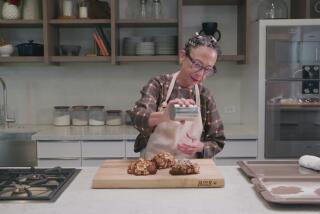New Uses for Old Crumbs
- Share via
They may be less romantic than pa^te and more overlooked than an after-dinner mint, but crackers have been an integral part of our dining experience for centuries. Salted or not, they’re the accompaniment of choice for soups and salads, and stacked with cheese they make a perfect snack.
Of course, they’re also a savvy cook’s best-kept secret.
An article headlined “Add Crackers--And Cook!” appeared in This Week Magazine (a Sunday supplement to The Times) on Aug. 25, 1940. As food writer Grace Turner explained, crackers help create “unusual and often very easily prepared dishes.” She suggested several dessert recipes that incorporate plain and salty soda cracker crumbs as well as crumbled Graham crackers, crushed zwieback and bits of cookies such as shortbread and vanilla wafers. The crumbs could be added to homemade ice cream before freezing, to custards before setting and to pie crusts that don’t require baking.
One recipe we chose to try--Apricot Whip--calls for sweet, buttery shortbread crumbs. It’s an old-fashioned, summery dish--a chilled gelatin mixture of whipped cream and apricots set in a mold. The shortbread provides texture and crunch.
Turner’s accompanying article focused on the history of the American cracker. She cited the value of the U.S. cracker business in 1940 at more than $280 million. “But it still preserves the ‘folksy’ tradition of the little fellows who first made crackers,” she wrote, describing how cracker bakers continued to supply consumers with regional favorites. In Michigan, residents preferred butter crackers; New Yorkers and other big-city dwellers favored crisp saltines.
Modern Crackers are originated from a hard, unleavened product known as ship’s biscuit, hardtack or pilot’s bread.
In 1801, a New England baker introduced the first biscuits to be called “crackers,” according to “The Food Chronology” by James Trager. Fine-grained and crisp, they made a cracking noise when eaten. This, of course, paved the way for the National Biscuit Co. (later Nabisco) to mass-produce the Premium soda (now Saltine) cracker in 1876 and the buttery Ritz cracker in 1934.
Thanks to Grace Turner’s timely reminder, now we can appreciate them all the more.
Apricot Whip
Active Work and Total Preparation Time: 25 minutes plus 2 hours 30 minutes chilling
1/2 tablespoon plain gelatin
3 tablespoons cold water
1 cup canned apricot syrup
1 cup whipping cream
3/4 cup crumbled shortbread
1 tablespoon lemon juice
6 to 8 canned apricot halves
* Soften gelatin in cold water 3 minutes. Heat apricot syrup over medium heat and stir in gelatin mixture until dissolved, 30 seconds.
* Chill until slightly jellied and beginning to set, 30 minutes. Whip until light and fluffy.
* Whip cream. Combine crumbled shortbread, whipped cream and lemon juice, then fold into gelatin mixture. Place apricot halves cut side up in bottom of 3-cup mold. Pour in gelatin mixture and chill until firm, 2 hours.
6 servings. Each serving: 275 calories; 29 mg sodium; 62 mg cholesterol; 19 grams fat; 24 grams carbohydrates; 3 grams protein; 0.33 gram fiber.
More to Read
Eat your way across L.A.
Get our weekly Tasting Notes newsletter for reviews, news and more.
You may occasionally receive promotional content from the Los Angeles Times.










